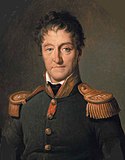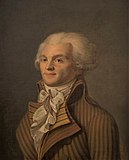1792 French National Convention election
| |||||||||||||||||||||||||||||||||
All 749 seats to the National Convention | |||||||||||||||||||||||||||||||||
|---|---|---|---|---|---|---|---|---|---|---|---|---|---|---|---|---|---|---|---|---|---|---|---|---|---|---|---|---|---|---|---|---|---|
| Turnout | 3,360,000 | ||||||||||||||||||||||||||||||||
| |||||||||||||||||||||||||||||||||
 Composition of the National Convention | |||||||||||||||||||||||||||||||||
| |||||||||||||||||||||||||||||||||
The first election for the National Convention of France was held in 1792. It established the nation's first government without a monarch.
The election of the deputies was held in early September and lasted three weeks;[1] they were the first to be held under universal male suffrage; royalist and Girondin candidates were boycotted.[2][3] To be an elector a citizen had to be over 21, resident one year in his department and not a domestic servant. An elector could stand as a candidate in any constituency. To be a delegate or a deputy an elector had to be over 25. If at the first ballot no candidate received an absolute majority of votes cast, there was to be a second ballot at which only the top two candidates of the first could compete.[4]
According to Malcolm Crook "Evidence of orchestrated attempts to intimidate rivals is not hard to find.[5][6]
An absolute majority of the male deputies elected belonged to the Marais party, a political faction of vague but largely moderate policies. The Montagnards or Jacobins received 200 seats and the republican, though more moderate Girondin faction 160 seats. According to Ian Davidson these are not hard numerical facts.[7] The election preceded the fall of the Girondins as a political faction, mainly because of the political and social unrest following the war started by the Girondin-dominated government in the spring of 1792.
Results
| Party | Votes | % | Seats | |
|---|---|---|---|---|
| Maraisards | 1,747,200 | 51.9% | 389 | |
| Montagnards | 907,200 | 26.7% | 200 | |
| Girondins | 705,600 | 21.4% | 160 | |
| Total | ca. 3,360,000[8] | 100% | 749 | |
References
- ^ Assemblée électorale de Paris 2 septembre, p. XI
- ^ Assemblée électorale de Paris 2 septembre, p. XVI
- ^ Crook, Malcolm (7 March 1996). Elections in the French Revolution: An Apprenticeship in Democracy, 1789-1799. Cambridge University Press. pp. 94–96. ISBN 978-0-521-45191-8. Retrieved 26 September 2022.
- ^ Cole, Alistair; Campbell, Peter (1989). French electoral systems and elections since 1789. Gower. pp. 38–39. ISBN 978-0-566-05696-3.
- ^ Crook, Malcolm (7 March 1996). Elections in the French Revolution: An Apprenticeship in Democracy, 1789-1799. Cambridge University Press. pp. 94–96. ISBN 978-0-521-45191-8. Retrieved 26 September 2022.
- ^ Edelstein, Professor Melvin (28 May 2014). The French Revolution and the Birth of Electoral Democracy. Ashgate Publishing, Ltd. pp. 266, 273. ISBN 978-1-4724-0699-6. Retrieved 26 September 2022.
- ^ The French Revolution: From Enlightenment to Tyranny, p. xiv
- ^ Dupuy, Roger (25 March 2014). République jacobine - Terreur, guerre et gouvernement révolutionnaire 1792-1794. Nouvelle histoire d (in French). Éditions Points. pp. 35–40. ISBN 978-2-7578-3937-9. Retrieved 26 September 2022.


